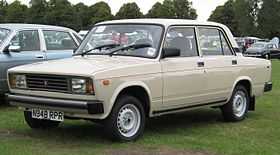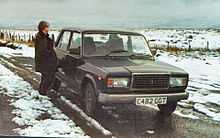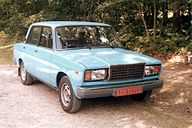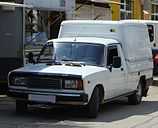Lada Riva
| Lada Riva | |
|---|---|
 | |
| Overview | |
| Manufacturer | AvtoVAZ |
| Also called |
Lada 2104 Lada 2105 Lada 2107 Lada Classic Lada Nova Lada 1500 (Canada) Lada Signet (Canada) Lada Laika (Argentina, Brazil) Lada Kalinka (Portugal, France, Germany, Spain) |
| Production |
2105: 1980 – December 2010[1] 2107: 1982– present[2][3] 2104: 1984–September 2012[4] |
| Assembly |
Tolyatti, Russia Izhevsk, Russia (IzhAvto)[2] Lutsk, Ukraine (LuAZ)[5] Cherkasy, Ukraine (Bogdan)[2] Kherson, Ukraine (Anto-Rus)[5] Kremenchuk, Ukraine (KrASZ)[5] Zaporizhia, Ukraine (ZAZ)[2] 6th of October City, Egypt[6] Dörpen, West Germany (Bohse) Ust-Kamenogorsk, Kazakhstan (Azia Avto)[7] |
| Body and chassis | |
| Class | Compact car |
| Body style |
4-door sedan 5-door estate |
| Layout | Front-engine, rear-wheel-drive |
| Related |
Fiat 124 SEAT 124 Izh 27175[8][9] Bohse Euro-Star[10][11][12] |
| Powertrain | |
| Engine |
1.2 L I4 (petrol) 1.3 L I4 (petrol) 1.5 L I4 (petrol) 1.6 L I4 (petrol) 1.7 L I4 (petrol) 1.7 L I4 (diesel) |
| Transmission | 5-speed manual |
| Dimensions | |
| Wheelbase | 2,419 mm (95.2 in) |
| Length | 4,120 mm (162.2 in) |
| Width | 1,617 mm (63.7 in) |
| Height | 1,442 mm (56.8 in) |
| Chronology | |
| Predecessor |
VAZ-2101 VAZ-2103 VAZ-2106 |
The VAZ-2105, VAZ-2104 and VAZ-2107 (collectively known as the Lada Riva in the United Kingdom and the Lada Nova in much of continental Europe) are a series of medium-sized family cars built by Russian car manufacturer AvtoVAZ, introduced in 1980 in the Soviet Union, and progressively in other European markets through the early 1980s and sold in both saloon and estate versions. AvtoVAZ cars are currently branded as Ladas.
Today they are generally referred to as the Lada Classic series,[4] being derived from the original Fiat 124 platform which has been the now-iconic mainstay of the AvtoVAZ lineup since the company's foundation in the late 1960s. The production in Russia ended between 2010 and 2012, however, the Lada 2107 remains in production in Egypt.
It is the third best selling automobile platform after the Volkswagen Beetle and the Ford Model T,[13][14] and one of the longest production run platforms alongside the Volkswagen Beetle, the Hindustan Ambassador and the Volkswagen Type 2.[15]
History
Although introduced in 1979 and first produced in quantity in 1980,[16] the Riva's origins are older: it is a restyled version of the original Lada type VAZ-2101 Zhiguli saloon,[16] which was introduced in 1970 and itself is a license copy of '1966-'1974 Fiat 124. The Riva itself is officially designated – and known in the home market – as VAZ-2105 (base saloon), VAZ-2104 (estate), and VAZ-2107 (deluxe saloon identified by the large chromed grille).Lada Riva design was copied from the '1975-'1980 SEAT 124,restyled by Giorgetto Giugiaro, which was based on license built '1966 Fiat 124['1968-'1974 SEAT 124].Other names sometimes used include Pyatyorka ("the five"), Chetvyorka ("the four") and Semyorka ("the seven"). In Russia, VAZ-2105, VAZ-2104, and VAZ-2107 are considered to be different cars rather than variants but nonetheless all of them are part of a single "Klassika" ("Classic") family along with older models such as the VAZ-2101.
Mechanically, the car is virtually identical to the first-generation VAZ-2101, featuring the Fiat-derived manual transmissions, coil spring suspension all round, and aluminum drum brakes on the rear wheels. The smaller-engined variant, the 65 hp (48 kW; 66 PS) 1,294 cc (79.0 cu in) version (VAZ-2105)[16] had a revamp of its inline four-cylinder compared to the original VAZ-2101 (Lada 1200). The old OHC design had its camshaft driven by chain, while the new one had a toothed belt drive. Nonetheless, the Riva's larger-engined version (VAZ-2107) carried on with the old 1,452 cc (88.6 cu in)[16] chain-driven OHC engine coming over from the original Lada 1500 (VAZ-2103) of 1973. Another change was made to the engine in 1992, when single point fuel injection and catalytic converters were specified in an attempt to keep up with emissions legislation.
The 2107 was announced in 1982, offered as the luxury version (and the most expensive), with improved interior (including front headrests), a new instrument panel, and chrome grille (resembling a Mercedes); it came with either 1,294 cc (79.0 cu in) (21072) or 1,570 cc (96 cu in) (21074) engines.[17] (The 21079 was a Wankel engined version.[17])
The first 2104 estate appeared in 1984, in three models: the 2104 with 1,294 cc (79.0 cu in); the 21041 with 1,198 cc (73.1 cu in); and the 21043 with 1,452 cc (88.6 cu in) (VAZ-2103) engine.[17]
Export sales proved to be very good, both in Eastern Europe and the West, including Britain, Finland, Holland, New Zealand (where it served as a taxi), and Canada[17] (the only market to offer whitewall tires[18]). Canadian 2107s were "briefly sold as the Dennis Signet", after the importer, Peter Dennis Motor Corporation.[19] Canadian sales, along with several European markets, ended on 4 July 1997.[20]
Tightening safety and emissions legislation led to the Riva being withdrawn from most Western European markets by 1997, although it remained in production at the AvtoVAZ factory in the Russian Federation and was sold as the Lada Classic. In 2002, production of the estate model was taken over by Izh,[21] before assembly was also started at the Bogdan Group's LuAZ plant, and later in Cherkasy. The 2107 model has been in production, not only at AutoVAZ but also at the ZAZ factory in Ukraine, and at Suzuki's factory in Egypt. In August 2011, Russian production of both the 2105 and 2107 have been completely moved to Izh.
In Britain
The British market was opened with the 1300GL in 1983,[22] and the 21051 (Riva 1200L) had the 1,198 cc (73.1 cu in).[17] British sales were based heavily on low sales price and durability.[17] In the 1986, 20,000 Ladas were sold in Britain, 30,000 in 1988.[23] The Lada Riva was featured twice on the British motoring program Top Gear. It appeared in season 1 in 2002, and again 6 years later in a segment looking at cars produced by the Eastern European Bloc during the Cold War. Top Gear does not like the Riva.
In the UK, its spartan interiors, dated styling and outdated mechanics meant that it was never actually aimed at buyers of market leaders' similar-sized products, such as the Ford Sierra, Vauxhall Cavalier and Austin Montego. The Riva was still selling well in the United Kingdom and many other western markets in the early 1990s, but the next few years saw a raft of new models come from budget competitors such as Daewoo, Hyundai, Kia and Proton, pushing Lada sales into terminal decline. This, combined with the much-needed investment to adapt cars to stricter European Union emissions requirements not being available, resulted in the decision to withdraw Lada from the UK (and some other European Markets) and Canada on 4 July 1997.[20]
New Zealand
The car was also sold in New Zealand, where it was distributed by the New Zealand Dairy Board. The Dairy Board received the cars in lieu of cash payments for deliveries of mutton and butter to the Soviet Union. The last such trade was carried out in 1990.[24]

Models
2104
The Estate
- VAZ-2104 - VAZ-2105 engine, a 1.3-litre carburetor, 4-speed transmission (CAT), the base model.
- VAZ-21041 - engine VAZ-2101, 1.2-litre, 4-carb item. PPC. Not commercially produced.
- VAZ-21042 - engine VAZ-2103, 1.5-litre, right hand drive.
- VAZ-21043 - engine VAZ-2103, 1.5-litre carburetor with a 4 - or 5-speed. CAT, in versions with electrical equipment and interior of the VAZ-2107 .
- VAZ-21044 - engine VAZ-2107, 1.7-litre, single injection, 5-speed. CAT, export model.
- VAZ-21045 - engine VAZ-2107, 1.8-litre, single injection, 5-speed. CAT, export model. Not commercially produced.
- VAZ-21045D - VAZ-341 engine, 1.5 litre, diesel, 5-speed. PPC.
- VAZ-21047 - engine VAZ-2103, 1.5-litre, carb, 5-speed. CAT, an improved version with the salon of the * * VAZ-2104/7 . Export modifications were equipped with the radiator grille of the VAZ-2107.
- VAZ-21048 - engine VAZ-343, 1.77-litre, diesel, 5-speed. PPC.
- VAZ-21041i - engine VAZ-21067 1.6 litres injector, 5-speed gearbox, interior and electrical VAZ-2107 car, the front seats of the IL-2126 .
- VAZ-21041 VF - radiator design VAZ-2107, VAZ-2103 engine of 1.5 litres injector, 5-speed gearbox, interior and electrical VAZ-2107 car, the front seats of the Izh-2126.
2105

- Lada 2105 - with the carb. engine VAZ-2105 (1.29 L, 63.6 hp, 92 N · m) and 4-speed. CAT;
- Lada 21050 - with the engine VAZ-2105 and 5-speed. CAT;
- Lada 21051 - with carb. engine VAZ-2101 (1.2 L, 58.7 hp, 85 N · m) and 4-speed. CAT;
- Lada 21053 - with carb. engine VAZ-2103 (1.45 L, 71.4 hp, 104 Nm) and 4 of Art. CAT;
- Lada 21053-20 - the engine VAZ-2104 (distributed injection, 1.45 L, 71.4 hp, 110 Nm, the Euro-2) and 5-speed. CAT;
- Lada 21054 - small scale spetsmodifikatsiya for the traffic police, the Interior Ministry and the FSB carb. engine VAZ-2106 (1.57 l, 80 hp, 122.5 N · m), equipped with an additional fuel tank and battery.
- Lada 21054-30 - the engine VAZ-21067 (distributed injection, 1.57 l, 72 hp, 116 Nm, the Euro-3) and 5-speed. CAT;
- Lada 21055 - small scale modification for the cab with a diesel engine VAZ (BTM) -341 production Barnaultransmash (1.52 L, 50.3 hp, 92 N · m);
- Lada 21057 (Lada Riva) - Export version of VAZ-21053 with right-hand drive and a single injection engine (Euro-1) was produced in 1992-1997 for the markets of the UK and countries with left-hand traffic;
- Lada 21058 (Lada Riva) - Export version of VAZ-21050 with right-hand drive, produced in 1982-1994 for the markets of the UK and countries with left-hand traffic;
- Lada 21059 - Debut 1980[25] as a small scale spetsmodifikatsiya for the traffic police, the Interior Ministry and the KGB with 120 hp (89 kW; 120 PS) 186 N·m (137 ft·lbf) two-rotor 1,300 cc (80 cu in) VAZ-411M or (slightly larger displacement) 140 hp (100 kW; 140 PS) VAZ-4132 Wankel engine (which both featured a 9.4:1 compression ratio)[26] and four-speed manual transmission.[25] Capable of 112 mph (180 km/h) and 0–60 mph (0–97 km/h) in nine seconds.[25] Priced at 52,000 rubles.[25]
- VIS -2345 - pick poluramnoy design based on VAZ-21053 and 21054, produced by JSC VAZInterService with 1995 by 2006 ;
- Lada 2105 VFTS (Lada VFTS) - a sports car, which was being built at the facilities of the Vilnius factory vehicles under the guidance of the legendary Soviet rallista Stasys Brundza. Homologated to FISA Group B standard. Markets forced engine VAZ-2106, using carburetors WEBER 45 DCOE (1,6 L 160 hp (at 7000 rev / min) 164.8 N · m (5500 rev / min)) and a spur 4 and 5-speed gearbox, with claw couplings include; since 1986 in order to reduce weight, the car was equipped with doors made of aluminum.
- Lada 2105 VIHUR - rally car produced industrial association for the production of sports equipment "Vihur" CC DOSAAF in Tallinn. Homologated for Group A-2/1 union classification (the so-called "queen-group"). According to the requirements of the A-2/1, the engines were serially unchanged.
2107
- Lada 2107 (Engine 2103, 1.5 liter, 8 cl., Carburetor)
- Lada 21072 (engine 2105, 1.3L, 8 cl., Carburetor, timing belt)
- Lada 21073 (1.7 L engine, Grade 8., Single injection - export version for the European market)
- Lada 21074 (engine 2106, 1.6 liter, 8 cl., Carburetor)
- Lada 2107-20 (motor 2104, 1.5L, 8 cl., Point Injection)
- Lada 2107-71 (1.4 liter engine., 66 hp engine 21034 for gasoline A-76, version for China)
- Lada 21074-20 (21067-10 engine, 1.6 liter, 8 cl., Distributed injection, Euro-2)
- Lada 21074-30 (21067-20 engine, 1.6 liter, 8 cl., Distributed injection, Euro-3)
- Lada 21077 (engine 2105, 1.3L, 8 cl., Carburetor, timing belt - export UK version)
- Lada 21078 (engine 2106, 1.6 liter, 8 cl., Carburetor - export UK version)
- Lada 21079 Debut 1982, fitted with 120 hp (89 kW; 120 PS) two-rotor 1,300 cc (80 cu in) VAZ-411M or (slightly larger displacement) 140 hp (100 kW; 140 PS) VAZ-4132 Wankel engine (which both featured a 9.4:1 compression ratio)[26] and five-speed manual transmission.[25] Capable of 112 mph (180 km/h) and 0–60 mph (0–97 km/h) in nine seconds.[25] Priced at 58,000 rubles.[25] Originally created for the needs of federal agencies: the traffic police, the Interior Ministry and KGB.
- Lada 2107 ZNG (21213 engine, 1.7 liter, 8 cl., Point Injection)
Other variants
Model variants included the Riva Signet, Riva 1200, Riva 1300, Riva 1500, and Riva 1600, with trim levels "E" and "L". A Turbo charged model Lada 2107 Turbo was sold in Finland, this version was made by Finnish Lada importer.
Small numbers of Lada rally cars were built with 150 hp (110 kW; 150 PS) Wankel engines, fitted with a pair of Weber DCOE twin-choke carburettors.[27]
Production at Suzuki Egypt
In Egypt, the Amal Foreign Trade Company and Lada's parent company AvtoVAZ signed a joint venture agreement to assemble Ladas for the North African market in 2000. However, as they did not have their own factory, space was found at a local Suzuki plant in Cairo to assemble the 2107 version of the Riva. As of 2006, production continued at Suzuki with an additional model, the 2110, being produced.
End of production
In the 2010s, the sales of the Lada Classics remained strong in the car's native Russia and some of the former Eastern Bloc nations. In April 2011, it was reported that Russian sales of the 2105 and 2107 series showed an increase of 140% on a total of 28,633 in the first quarter of the year.[28] However, production of the 2105 ceased at AvtoVAZ's Togliatti plant at the end of 2010 after a 30-year production run and nearly 3,000,000 units, with production of the other variants being fully subcontracted to the IzhAvto plant near Izhevsk in a strategic alliance with AvtoVAZ.[1]
The 2107 made the transition to the IzhAvto plant in August 2011, rumoured to be in preparation for the launch of the Lada 2116, thus marking the end of production of the original Fiat 124 derived models at Tolyatti after a 41-year production run and over 14 million units.
In September 2012, the history of the sedan model in Russia was over, when the last 2104 came off the IzhAvto assembly lines.[2] The last unit of the Lada Classic series, a 2104 model, was produced by IzhAvto on 17 September 2012.[4] Starting from the same month, production at the Izhevsk factory will be replaced with the new Lada Granta.[29] However, 2107 model is still in production in Egypt.
Image gallery
|
References
- ↑ 1.0 1.1 "The cheapest Russian car was removed from production". Autostat. 14 February 2011. Retrieved 18 April 2012.
- ↑ 2.0 2.1 2.2 2.3 2.4 "ИжАвто" выпустил последнюю "семерку" [IzhAvto" produced the last "semyorka"] (in Russian). Autocentre.ua. 17 April 2012. Retrieved 18 April 2012.
- ↑ "АвтоВаз выпустил последний классический автомобиль Lada" [AvtoVAZ produced the last Lada Classic car] (in Russian). BBC Russian. 17 September 2012. Retrieved 7 October 2012.
- ↑ 4.0 4.1 4.2 "17 сентября будут сделаны последние "Жигули"" [The last Zhiguli will be produced on 17 September] (in Russian). Auto.Mail.Ru. 11 September 2012. Retrieved 12 September 2012.
- ↑ 5.0 5.1 5.2 "Annual Report 2003" (PDF). JSC Avtovaz. 29 July 2005. Retrieved 11 April 2012.
- ↑ "Lada. Lada In Egypt". Car-cat.com. Archived from the original on 8 July 2011. Retrieved 10 July 2010.
- ↑ "Company / Plant History". Aziaavto.kz. Retrieved 7 December 2010.
- ↑ "ИжАвто" сокращает производство из-за низкого спроса на "классику" ["IzhAuto" reduces production due to low demand for "classic"] (in Russian). Autocentre.ua. 21 March 2012. Retrieved 18 April 2012.
- ↑ "АвтоВАЗ" завершил выпуск последней "классической" модели ["AvtoVAZ" rolled of the last unit of the "classical" model] (in Russian). Lenta.ru. 17 September 2012.
- ↑ "Bohse Euro-Star brochure". Storm.oldcarmanualproject.com. Retrieved 10 July 2010.
- ↑ Börger, Andre. "Bohse EuroStar". Cabrionews.de. Archived from the original on 8 August 2007. Retrieved 10 July 2010.
- ↑ "The Bohse Euro-Star: a unique no-nonsense car". Bohse.nl. Archived from the original on 8 March 2012. Retrieved 10 July 2010.
- ↑ Kowalke, Ron (1997). Standard Catalog of American Cars 1946–1975. Krause publications. ISBN 0-87341-521-3.
- ↑ Giles Chapman (1 September 2005). Car emblems: the ultimate guide to automotive logos worldwide. Merrell. p. 154. ISBN 978-1-85894-317-6. Retrieved 2 October 2013.
Combined with the Fiat 1 24, it's the third best- selling single model design of all time, after the Volkswagen Beetle and Ford Model T.
- ↑ "The Oldest Cars Still In Production". Jalopnik. 14 May 2012. Retrieved 31 December 2013.
- ↑ 16.0 16.1 16.2 16.3 Andy Thompson (2008). Cars of the Soviet Union: The Definite History. Sparkford, Yeovil, Somerset: Haynes. p. 226. ISBN 978 1 84425 483 5.
- ↑ 17.0 17.1 17.2 17.3 17.4 17.5 Thompson, p. 229.
- ↑ Thompson, p. 227 (caption).
- ↑ Thompson, p. 232 (caption).
- ↑ 20.0 20.1 Rogers, Peter. "UK Lada history". Lada Owners Club of GB. Archived from the original on 21 October 2010.
- ↑ "На "ИжАвто" выпущена 100-тысячная Lada 2104" [IzhAvto produced the 100,000th Lada 2104] (in Russian). Autocentre.ua. 7 March 2008. Retrieved 18 April 2012.
- ↑ Thompson, p. 228 (caption).
- ↑ Thompson, pp. 232 & 235.
- ↑ Brown, Bruce (1 March 1999). "New Zealand in the World Economy: Trade Negotiations and Diversification". New Zealand in World Affairs, 1972-1990 (Wellington, New Zealand: Victoria University Press) 3: 44. ISBN 978-0864733726.
- ↑ 25.0 25.1 25.2 25.3 25.4 25.5 25.6 Thompson, p.236.
- ↑ 26.0 26.1 Thompson, pp.115 and 236.
- ↑ Thompson, p.237.
- ↑ "Sales of cars and LCVs in Russia up 77%". RIA Novosti. 8 April 2011. Retrieved 18 April 2012.
- ↑ История вазовской "классики" завершится 17 сентября [VAZ Classic history will end on 17 September] (in Russian). Auto.Vesti.Ru. 12 September 2012. Retrieved 19 September 2012.
External links
- Lada and Fiat model (Russian)
- Lada Cars reviews, images, infos (English)
| ||||||||||||||||||||||||||||||||
| Lada, a brand of AvtoVAZ, car timeline, 1970–present | |||||||||||||||||||||||||||||||||||||||||||||||
|---|---|---|---|---|---|---|---|---|---|---|---|---|---|---|---|---|---|---|---|---|---|---|---|---|---|---|---|---|---|---|---|---|---|---|---|---|---|---|---|---|---|---|---|---|---|---|---|
| Type | 1970s | 1980s | 1990s | 2000s | 2010s | ||||||||||||||||||||||||||||||||||||||||||
| 0 | 1 | 2 | 3 | 4 | 5 | 6 | 7 | 8 | 9 | 0 | 1 | 2 | 3 | 4 | 5 | 6 | 7 | 8 | 9 | 0 | 1 | 2 | 3 | 4 | 5 | 6 | 7 | 8 | 9 | 0 | 1 | 2 | 3 | 4 | 5 | 6 | 7 | 8 | 9 | 0 | 1 | 2 | 3 | 4 | 5 | ||
| City car | Oka | ||||||||||||||||||||||||||||||||||||||||||||||
| Supermini | Kalina | Kalina | |||||||||||||||||||||||||||||||||||||||||||||
| Granta | |||||||||||||||||||||||||||||||||||||||||||||||
| Compact car | 1200 | ||||||||||||||||||||||||||||||||||||||||||||||
| 1500 | |||||||||||||||||||||||||||||||||||||||||||||||
| 1600 | |||||||||||||||||||||||||||||||||||||||||||||||
| Riva | Largus | ||||||||||||||||||||||||||||||||||||||||||||||
| Samara / Sputnik | Samara | ||||||||||||||||||||||||||||||||||||||||||||||
| 110 / 111 / 112 | |||||||||||||||||||||||||||||||||||||||||||||||
| Priora | |||||||||||||||||||||||||||||||||||||||||||||||
| Minivan | Nadezhda | ||||||||||||||||||||||||||||||||||||||||||||||
| Off-road | Niva | Taiga | |||||||||||||||||||||||||||||||||||||||||||||



